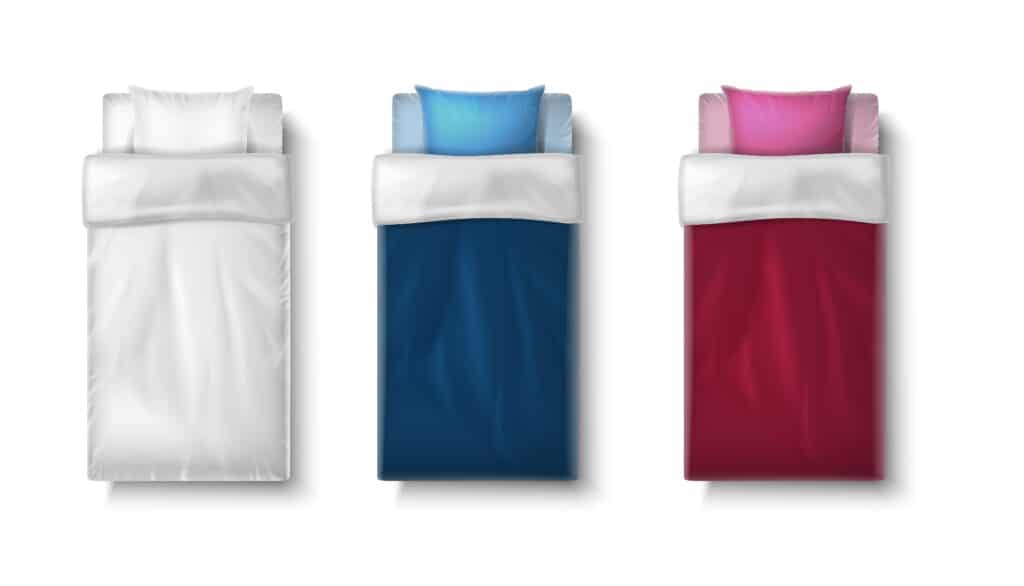- You are here:
- Home »
- Nontoxic Furniture »
- Single vs Twin Bed: What’s the Difference?
Single vs Twin Bed: What’s the Difference?
You may be wondering what the difference is between a single bed and a twin bed. In short, there is no difference. Both terms can be used interchangeably to describe the same bed size. In this article, we’ll take a closer look at the history of these two terms, and how they came to be used interchangeably.

What’s the Difference between a Single and Twin Bed?
Single and twin are terms that are used to describe beds that are the same size. Both terms can be used interchangeably, and there is no difference in meaning between them. The term “single” was more common in the past, but nowadays the term “twin” is more commonly used. However, some countries, such as UK, still use the term “single” more often.
The twin (single) bed size is the smallest standard mattress size, generally measuring 38 inches by 75 inches (sometimes 39″ by 75″). This makes it ideal for children, single adults, or use in a guest room. It’s important to note that the twin bed size is designed for only one sleeper; couples may find it too small for comfort.
If you’re looking for a mattress for two people, you’ll need to opt for a larger size, such as a full or queen. However, if you’re looking for a single bed for a child or teenager, the twin bed size is a great option. It’s also a good choice if you need a bed for a guest room but don’t have a lot of space to spare.
The History of the “Single” and “Twin” Terms
The term “twin bed” dates back to when hotels started to place two single beds in the same room. The key here is that twin beds are not simply two mattresses side-by-side; they’re two separate bed frames, with their own headboards, footboards, and bedding. This arrangement was popular because it saved hotels space and money.
Today, twin beds are still popular in hotels and guest rooms, but they’ve also become a go-to option for small bedrooms or shared spaces. And while you might associate twin beds with kids’ rooms, they can actually work for any age group.

The Benefits of a Single/Twin Bed
Twin or single beds offer a few key benefits:
- Twin beds are perfect for smaller bedrooms or shared spaces.
- They’re also a good option for kids’ rooms.
- Twin beds are typically less expensive than queen or king beds.
- They’re also easier to move and transport.
- They offer more flexibility than a larger bed because you can use them in different ways.
- Twin beds can be pushed together to create a larger bed.
- You can also use twin beds as daybeds.
- Twin beds can be a good option for guest rooms.
- They can also be a good option if you have a small space.
Single vs Twin XL Bed Size
The twin XL bed size is the same width as a twin bed, but it’s five inches longer. This makes it a good option for taller sleepers, such as teenagers or adults.
The extra length can also be helpful if you want to use the bed as a daybed. The twin XL bed size is less common than the twin bed size, but it’s still widely available. In terms of price, the twin XL bed is typically more expensive than the twin bed.
Twin or Single Bed Alternatives
If you’re looking for something a little different, there are a few alternatives to twin or single beds:
- Bunk beds: Bunk beds are perfect for kids’ rooms or guest rooms. They take up less space than two twin beds and are also great for sleepovers.
- Daybeds: Daybeds can be used as a sofa during the day and a bed at night. They’re perfect for small spaces and offer more flexibility than a twin bed.
- Futons: Futons can be used as a sofa during the day and a bed at night. They’re perfect for small spaces and offer more flexibility than a twin bed.
- Murphy beds: Murphy beds are perfect for small spaces. They are wall-mounted beds that fold up into the wall when not in use.
- Loft beds: Loft beds are perfect for kids’ rooms or small spaces. They have a mattress on top and an open space underneath that can be used for storage, a desk, or a play area.
- Twin XL beds: Twin XL beds are the same width as a twin bed but are 5 inches longer. They’re perfect for taller adults or teens.
- Full beds: Full beds are slightly wider than twin beds and are a good option if you need more space to sleep.
If you’re looking for a bed for a small space, a twin or single bed might be the perfect option for you. They offer many benefits and are less expensive than larger beds.
Conclusion
As you can see, a twin bed and a single bed are exactly the same thing. The only difference is that one is used in the United States while the other is more common in Europe. So, if you’re ever confused about which term to use, remember that they both refer to the exact same type of bed.
About the Author Kamila Flieger
My name is Kamila, and I'm passionate about researching non-toxic, organic products for the home. I believe it's so important to create a safe and healthy environment for our families, and I enjoy helping others do the same.

